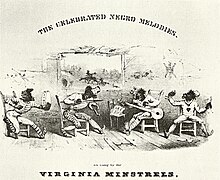
Back Minstrel AST Minstrel show Catalan Minstrel show Czech Minstrel Show German Minstrel Spanish Minstrelite etendused ET Minstrel show Finnish Minstrel show French Minstrelsy GL מופע מינסטרל HE
This article may need to be rewritten to comply with Wikipedia's quality standards. (July 2023) |

The minstrel show, also called minstrelsy, was an American form of theater developed in the early 19th century.[1] The shows were performed by mostly white actors wearing blackface makeup for the purpose of comically portraying racial stereotypes of African Americans. There were also some African-American performers and black-only minstrel groups that formed and toured. Minstrel shows stereotyped blacks as dimwitted, lazy, buffoonish, cowardly, superstitious, and happy-go-lucky.[2][3] Each show consisted of comic skits, variety acts, dancing, and music performances that depicted people specifically of African descent.
Blackface minstrelsy was the first uniquely American form of theater, and for many minstrel shows emerged as brief burlesques and comic entr'actes in the early 1830s in the Northeastern states. They were developed into full-fledged art form in the next decade. By 1848, blackface minstrel shows were the national artform, translating formal art such as opera into popular terms for a general audience.[4] During the 1830s and 1840s at the height of its popularity, it was at the epicenter of the American music industry. For several decades, it provided the means through which American whites viewed black people. On the one hand, it had strong racist aspects; on the other, it afforded white Americans more awareness, albeit distorted, of some aspects of black culture in America.[5][6] Although the minstrel shows were extremely popular, being "consistently packed with families from all walks of life and every ethnic group",[7] they were also controversial. Integrationists decried them as falsely showing happy slaves while at the same time making fun of them; segregationists thought such shows were "disrespectful" of social norms as they portrayed runaway slaves with sympathy and would undermine slavery.[8]
During the Civil War, minstrelsy's popularity declined. By the turn of the 20th century the minstrel show enjoyed but a shadow of its former popularity, having been replaced for the most part by the Vaudeville style of theatre. The form survived as professional entertainment until about 1910; amateur performances continued until the 1960s in high schools and local theaters.[9]
The typical minstrel performance followed a three-act structure. The troupe first danced onto stage then exchanged wisecracks and sang songs. The second part featured a variety of entertainments, including the pun-filled stump speech. The final act consisted of a slapstick musical plantation skit or a send-up of a popular play. Minstrel songs and sketches featured several stock characters, most popularly the slave and the dandy. These were further divided into sub-archetypes such as the mammy, her counterpart the old darky, the provocative mulatto wench, and the black soldier. Minstrels claimed that their songs and dances were authentically black,[10] although the extent of the genuine black influence remains debated. Spirituals (known as jubilees) entered the repertoire in the 1870s, marking the first undeniably black music to be used in minstrelsy.
The genre has had a lasting legacy and influence and was featured in the British television series The Black and White Minstrel Show as recently as the mid-1970s. Generally, as the civil rights movement progressed and gained acceptance, minstrelsy lost popularity.[citation needed]
- ^ "Minstrel show | Description, History, & Facts | Britannica". www.britannica.com.
- ^ The Coon Character Archived 2012-04-14 at the Wayback Machine, Jim Crow Museum of Racist Memorabilia, Ferris State University. Retrieved 29 January 2016.
- ^ John Kenrick, A History of the Musical: Minstrel Shows Archived 2012-06-11 at the Wayback Machine, musicals101.com. 1996, revised 2003. Retrieved 9 November 2011.
- ^ Behind the Burnt Cork Mask: Early Blackface Minstrelsy and Antebellum American Popular Culture by William J. Mahar, University of Illinois Press (1998) p. 9 ISBN 0-252-06696-0.
- ^ Lott 1993, pp. 17–18
- ^ Watkins 1999, p. 82
- ^ Sweet, Frank W. A History of the Minstrel Show, p27.
- ^ A History of the Minstrel Show (2000) By Frank W. Sweet, Backintyme, p. 28 Retrieved 18 March 2010.
- ^ Meehan, Sarah (February 8, 2019). "Blackface photos found in old University of Maryland yearbooks". The Baltimore Sun. Retrieved February 3, 2020.
- ^ Nowatzki, Robert (2010). Representing African Americans in Transatlantic Abolitionism and Blackface Minstrelsy. Baton Rouge: LSU Press. p. 36. ISBN 978-0-8071-3745-1.